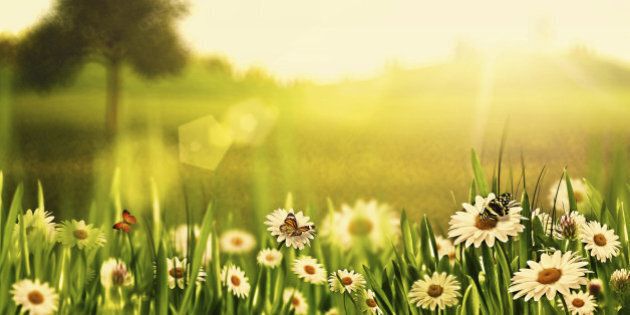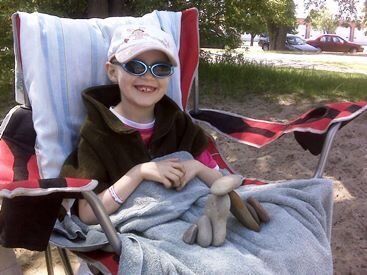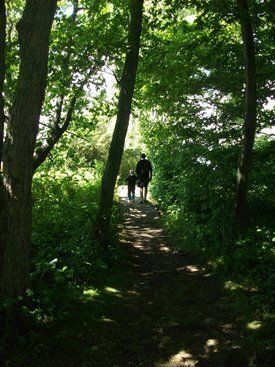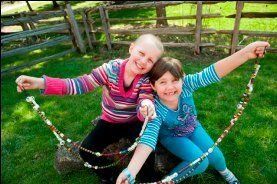
When I was growing up, my Dad, a fish biologist with the Department of Fisheries & Oceans, really wanted one of his kids to become a scientist. I did not want to be a scientist, but always wanted to talk about nature and share the stories about why our natural heritage is important.
I have always valued the guidance of science, respected nature and was passionate about conservation. Most of my career has involved managing communications activities for social profit and environmental organizations. My professional life has always been connected to nature. But I never realized how much nature meant to me, personally, until tragedy struck.

Lily at the beach, May 2010 (Photo by Rebecca Hull/NCC staff)
In 2010, our five-year-old daughter, Lily, was complaining about back pain and we had repeatedly gone to the doctors at the walk-in clinic to find out why. After many visits to the clinic, and then finally to the local hospital, it was discovered that Lily had multiple back fractures. She was diagnosed Acute Lymphoblastic Leukemia (ALL), which caused these small fractures and the thinning of her bones.
The total length of her therapy was over two years and much of it was spent in and out of McMaster Children's Hospital. One of the side effects of therapy is neutropenia, which meant Lily's blood counts were very low, making her vulnerable to germs and infections. During this time, Lily was unable to spend time in public places and most of her time was spent in a hospital bed in isolation.

Lily holding hands with her Dad at Camp Trillium, a camp for children with cancer and their families. (Photo by Rebecca Hull/NCC)
With spending so many hours and days in the hospital, we not only realized how difficult it was to not be outside, but discovered how much of our family time revolved around doing things together outdoors. We spent family time together at conservation areas and provincial parks, swam at the local beach, walked our dogs, visited the neighbourhood park and went for regular after dinner walks. We were a healthier, and more connected, family when we spent our time outdoors.
Whenever Lily was released from the hospital, and the weather cooperated, we headed outside. If our family was feeling sad or we all felt overwhelmed, we would plan "mini outdoor adventures" to help rejuvenate our spirits and connect to each other as a family. We really started to depend on these adventures, these outdoor excursions, to get us through the bad days and help Lily along her road to recovery.
One of our favourite family memories involved us "kidnapping" (Lily's words) Lily to take her down to the Lasalle Park Marina to see the swans. Hundreds of swans come in the spring and the fall to the marina. We put Lily in her wheelchair, bundled her up and headed to the dock. We fed the swans, took a walk along the boardwalk and laughingly raced each other along the paths. I really believe that our family was made stronger, Lily was healthier and our spirits were better because we were able to escape the isolation of the hospital and get outdoors.

Lily's bravery beads. Each represents a different part of Lily's treatment and the necklaces shows the story of her journey (i.e. green beads represent each time she received chemotherapy). (Photo by Rebecca Hull/NCC staff)
Green is really good for you. Numerous studies show that life happens when you spend it outside -- you are building your well-being, connecting to other people and your community, engaging in adventure therapy and taking notice of nature.
According to the National Environmental Educational Foundation, exposure to nature can reduce stress levels by as much as 28 per cent in children. Health benefits of nature may include reduced anxiety and depression, increased energy and immunity, decreased stress and improved mental health.
Based on my life experience, I know this much is true: our daughter is now a healthy and energetic 11-year-old, our family is stronger and happier, and our best family memories were created by nature.
Nature helped us weather the storm, was the glue that held us together and took us outside of ourselves and our struggles. Now, I have my own stories to tell about what nature means to me and why my natural heritage is important.
Most importantly, my daughters have their own nature stories to share and pass down to their children. And that, my friends, is priceless.
Written by Rebecca Hull, communications manager for the Ontario Region of the Nature Conservancy of Canada (NCC). This post originally appeared on www.LandLines.ca, the NCC blog.
ALSO ON HUFFPOST: